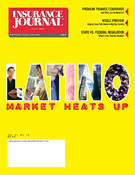It is nearly impossible to deny the impact the burgeoning Hispanic population has and will have on American culture and its markets. The marketplace for insurance is no exception.
Hispanics are now the country’s largest minority group, having officially overtaken African Americans in recent population estimates issued by the U.S. Census Bureau, which showed that in 2002 there were 38.8 million Hispanics in the United States, compared with 38.3 million African Americans. Hispanics accounted for nearly half of the country’s population increase of 7 million, to 288.4 million, since 2000.
Unless there is a steep economic decline in the United States lowering the demand for cheaper, less-skilled labor or precipitous growth in Mexico and the rest of Latin America reducing the supply of that labor, the U.S. Hispanic marketplace will only continue to grow.
The Census Bureau estimates that by 2025, Hispanics will number 61.4 million, 18.2 percent of the U.S. population.
Census figures also show that Hispanics account for $800 billion a year in goods and services, and Hispanic buying power will only increase with time. The University of Georgia’s Selig Center for Economic Growth estimates Hispanic buying power will approach $926.1 billion by 2007, and Hispanics had a 7.6 percent share of overall buying power in 2002.
That buying power is growing at a compound annual rate of 8.7 percent, while the non-Hispanic rate is growing by only 4.8 percent a year.
Even American retailer Sears, Roebuck and Co. is tapping into the trend, announcing in June that it would tie a line of women’s clothing to Spanish-language television celebrity Lucy Pereda, dubbed the Hispanic Martha Stewart.
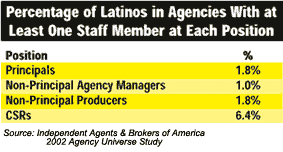
Glass half empty … and half full
“I suspect the numbers today indicate that Hispanics are under-indexed for insurance, which indicates opportunities for corporate America,” said Jeffrey Humphreys, director of the Selig Center.
While Humphreys did not have figures on how Hispanics compare to the rest of the population when it comes to consumption of auto, homeowners and other property/casualty lines, Hispanics do purchase what the U.S. Bureau of Labor Statistics calls “life insurance and other personal insurance” at a considerably lower rate.
The typical household spends one percent of its after-tax income on personal insurance, while the average Hispanic household spends only 0.6 percent, which Humphreys called “a fairly big gap.” In dollar amounts, the average consumer spends $399 a year on personal insurance, compared to $180 annually for Hispanics. Also, only 47 percent of Hispanics are homeowners, compared to 68 percent of non-Hispanics.
As for education, only 57 percent of Hispanics have had secondary education, compared to nearly 80 percent of whites. That figure is primarily affected by the number of Mexican-Americans—who account for 67 percent of U.S. Hispanics—nearly half of whom arrive in the United States with no high school diploma.
“The glass might be half empty from today’s perspective,” Humphreys said, “but it’s half full if you’re looking at it from a future perspective … There is above average potential in Hispanic market for growth. People buy insurance as incomes rise, and Hispanic incomes are rising.”
Targeting the market
While the major, standard providers have made some efforts to target the Hispanic, Spanish-language market, independent agents are in the forefront of any move to take advantage of the opportunity the market offers.
“The real story might be to look at what independent agents in Hispanic communities offer their customers,” said Matthew Collister, a spokesman for leading vehicle insurer Progressive Corp. “The value of the personalized service and counsel that an agent provides is magnified when the issue of language comes into play.”
Yet, as with the numbers for other minority groups, the number of Latino agents is badly disproportionate to their representation in the populace as a whole. The Independent Insurance Agents & Brokers of America (IIABA) 2002 Agency Universe Study found that only 1.8 percent of agency principals are Latino, while only one percent of non-principal agency managers are Latino.
Hispanics account for 1.8 percent of non-principal producers, though 6.4 percent of CSRs are Latino, perhaps indicating that more and more agencies feel the need for Spanish-speaking help at some level.
The IIABA’s Diversity Task Force does have some major insurers represented on its board—CNA, Chubb, Zurich North America, Travelers and Safeco—but their efforts to recruit and train Hispanic agents seem to have fallen short so far.
That said, Progressive has a Spanish-language Web site, as does Safeco Insurance, and agents report a great deal of improvement in the last few years in carriers’ ability to handle claims service and other issues in Spanish.
“The companies realize that they have to start accommodating that type of clientele,” said Rafael Hurtado, principal at Net 4 Insurance in South Pasadena, Calif. “Luckily, the carriers have hired that type of staffing to handle that. In the past, maybe 10 years ago, it was a problem for people communicating with carriers. But now they have picked up claims people and customer service people who are bilingual.”
The Insurance Information Institute (I.I.I.), also, has recognized a need. Through an alliance with Terra.com, the U.S. Hispanic portal of the Terra Lycos Network, it aims to connect Spanish-speaking consumers with insurance companies in all 50 states and the District of Columbia. The I.I.I.’s “Find an Insurance Company” Web-tool is available in Spanish on the “Mi Dinero” section of www.terra.com. It allows consumers to select the state they live in and the type of insurance they are looking for. A random list of insurance companies will be displayed with links directly to the individual company Web sites.
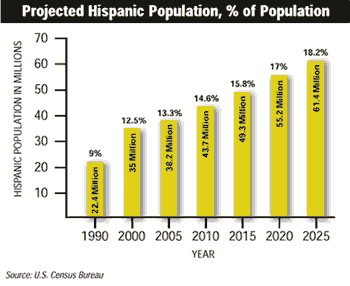
Higher level of service required
Hurtado estimated that one out of 10 of his Spanish-speaking customers come directly to the agency for help with making claims. A willingness to offer that kind of elevated service is one of the major differences in serving Hispanic community which will make or break any agency’s effort to reach out to them.
For example, many Hispanics prefer to pay in person, in cash, and agencies need to orient their businesses to serve that preference. In South Texas, the immigrant culture very much resembles the “Mexican frontera,” according to Ruben Villareal, vice president of operations for Underwriters MGA in McAllen, Texas.
“We have a lot of the population here that has migrated into the states,” Villareal said. “One of the things that has happened in South Texas is that because the immigrants are coming from Mexico, their ancestors were used to dealing without bank accounts. They paid on a monthly basis, and a lot of that has stuck. We still have a good percentage of the migrants who come in from Mexico and deal without bank accounts and use either cash or money orders.”
Underwriters MGA, which provides non-standard auto insurance through Dallas-based Old American County Mutual and San Diego-based Anchor General Insurance Agency Inc., also offers its agents a 30-day auto policy for the many Mexican-American customers unwilling to make a longer commitment.
“One of the things that might make a difference is that we’re dealing with a lot of people who are at or below poverty level,” Villareal said. “Where we see our production fluctuate is during the holidays. Our assumption is that when Christmas time comes around, people decide between a Christmas tree and a 30-day policy.” Still, Villareal said there are customers who have renewed the 30-day policy for as long as 18 consecutive months.
“They are very loyal customers,” he said.
Villareal estimated that 95 percent of the retail agents it does business with are Hispanic, running along the Texas-Mexico border from Brownsville to El Paso.
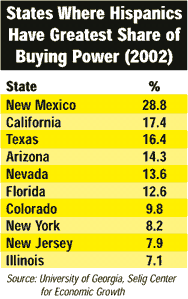 Plan for success from day one
Plan for success from day one
Catering to the specific needs of Hispanic insurance buyers was the plan from day one at Oasis Insurance Services Inc., owned by Latin American Agents Associations (LAAA) CEO Andre Urena. He and his founding partner chose a name that made sense in English and Spanish, for example.
They also chose to situate their offices in the Hispanic bedroom communities of Southern California. Oasis now has six offices in San Diego, six in Los Angeles and two in Northern California.
“I was born in Costa Rica,” Urena said. “I understand that Hispanic needs are different from the regular population. The typical Hispanic will not do business through an 800 number. They prefer face-to-face treatment. They prefer to do business with someone they establish a relationship with. The over the phone thing does not go as well. Once they trust you, they are very loyal.”
Urena said he also noticed his customers did not like to mail in payments. “They prefer to come in and make the payment and say hello to the people,” Urena said. “They want a smaller community type feel. They are intimidated by a place that looks too professional, so we try to make our offices more inviting—like a travel agent would have his location. We have long counters so that we can help customers right away. Attention is prompt, and you’re going to get a smile.”
Urena said that doing business with Hispanics offers several advantages for the agent. For example, Hispanics are more likely to provide referrals to family members, co-workers and friends.
“Referrals have better loss ratios and its better business overall than the guy next door who gets his business from ads on the radio or in the Yellow Pages,” Urena said. “Our customer stays on the books longer, and not only has his auto policy with us, but his homeowners and business policies with us too.”
Other Hispanic agents concur.
“We do a ton of referral business,” said Daniel Baptista, principal at Sol Insurance Agency, located 14 blocks from downtown Miami, Fla. “It’s incredible. The one thing people don’t realize in this business is that when you treat one member of a Hispanic family the way they like to be treated, everybody in the family tends to make a phone call afterwards.”
Baptista is of Portuguese descent and grew up in Toronto, Canada, before relocating to Miami. He speaks Spanish, French and Portuguese (in addition to English, of course), and said that about 80 percent of his clients are Spanish speaking.
Baptista, president-elect of the Florida-based Latin American Association of Insurance Agents (LAAIA), says an agency looking for success in the Hispanic marketplace should “take an active role in the community, whether it’s charitable donations or just understanding the community they’re in.
“The Hispanic market certainly appreciates the option of either speaking English or Spanish, and it’s important to have them feel comfortable at that level. It allows them to ask the questions they want answered. Feeling uncomfortable in English holds them back from asking a question, so being bilingual makes it a very successful process when it comes to catering to the insurance needs of our clients.”
Baptista said this level of service should extend to printed materials and ensuring that they be available in Spanish or English, depending on the customer’s preference.
More important, Bapista said, is creating a “learning curve” among Hispanic insurance buyers. Everything from understanding how to write a check to what it takes to drive legally to explaining the basics of risk and how insurance can ameliorate it may need to be offered, “so they can make intelligent decisions on their own. I don’t think a lot of agencies put a lot of emphasis on this as we do in this market.”
Seeking the diamonds in the rough
Whether standard and preferred insurance providers can take advantage of the type of elevated customer service offered by Hispanic agents remains an open question. All of the agents interviewed for this story agreed that the appointment process remains a difficult one. A major goal of both California’s Latin American Agents Association and Florida’s Latin American Association of Insurance Agents is to help connect their members with companies looking to tap the Hispanic marketplace.
“You don’t want to pass judgment too many times with too many companies,” Baptista said. “As an agent, the only thing you have is your reputation and your track record. National carriers need to go out of their way to start looking at these dynamic markets. They need to look for the diamond in the rough. I don’t think they’ve done enough of that. There are a lot of good agents out there that haven’t been considered who should be.”
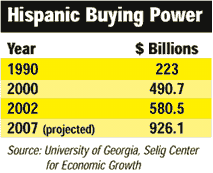 Another goal is to help recruit younger Hispanics into the business. Urena said LAAA has attempted to reach out to Hispanic college students through career fairs. Just making young people aware of insurance as a career is a hurdle, he said.
Another goal is to help recruit younger Hispanics into the business. Urena said LAAA has attempted to reach out to Hispanic college students through career fairs. Just making young people aware of insurance as a career is a hurdle, he said.
The IIABA’s InVEST program, which educates high school and community college students about careers in insurance, does have about 65 percent minority participation, according to Diversity Task Force staff liaison Barbara Miller-Richards.
A matter of time
It may just be a matter of time before the agency force catches up with the demographic trends. And with time too will come more upscale, more educated Hispanic insurance consumers.
“I think that the Hispanic population—the Hispanic generation—is becoming wiser as consumers,” said Hurtado of Net 4 Insurance. “They should not be neglected. They should be catered to … They’re not here today and gone tomorrow. They’re good customers.”
Was this article valuable?
Here are more articles you may enjoy.

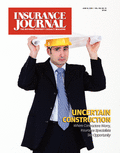
 ‘Generali’ Sign Atop Insurer’s Skyscraper Offices Collapses in Milan
‘Generali’ Sign Atop Insurer’s Skyscraper Offices Collapses in Milan  Insurance Sector Should Be on the Lookout for ‘Scattered Spider’ Hackers
Insurance Sector Should Be on the Lookout for ‘Scattered Spider’ Hackers  Google Owes $314 Million for Misusing Android Cell Phone Data
Google Owes $314 Million for Misusing Android Cell Phone Data  Aflac Hit With Class Action Over Data Breach of Customer Info
Aflac Hit With Class Action Over Data Breach of Customer Info 